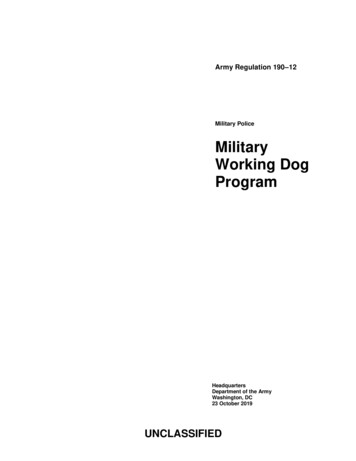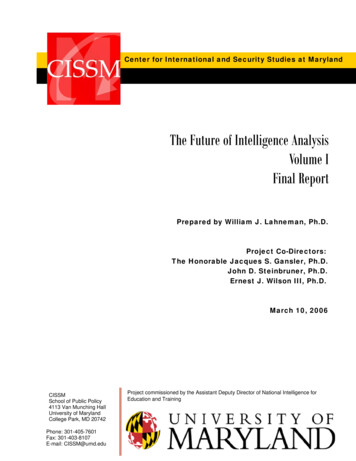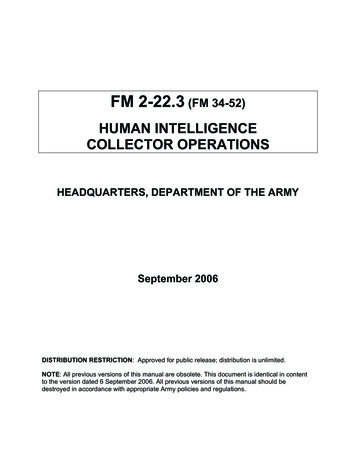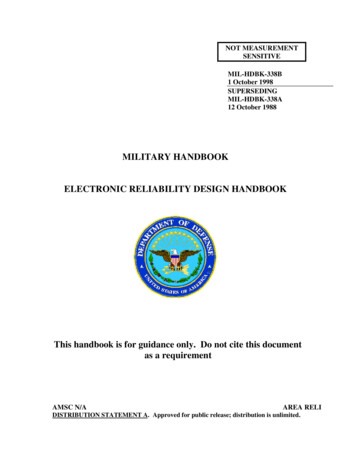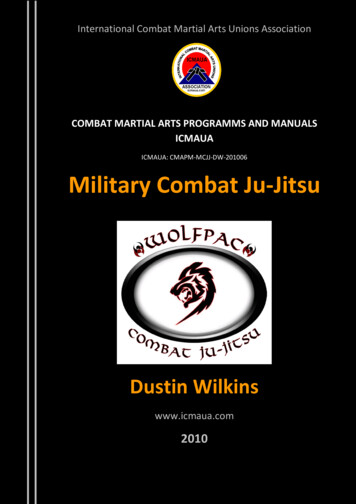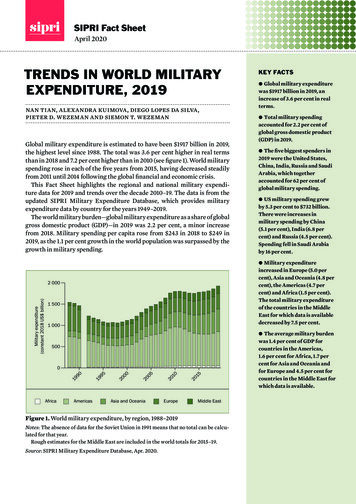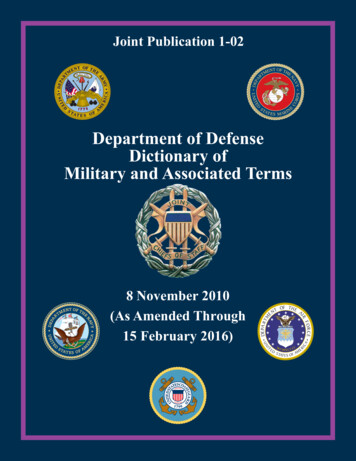
Transcription
Cultural Intelligence for Military OperationsPashtuns in AfghanistanSummary of Key Issues With a population of over ten million people, the Pashtun ethnic group is thelargest ethnic group in Afghanistan. The Pashtun ethnic group, like all ethnic groups in Afghanistan, consists ofnumerous tribes that center around common genealogies and geographicareas. These tribes, however, do not necessarily constitute unique ethnicidentities. The two major Pashtun tribes include the Durrani (3.3 million),and the Ghilzai (4.4 million). The Pashtuns are mainly Sunni Muslims of the Hanafi school, although thereare some Shia Pashtuns in eastern Afghanistan. Most Pashtuns see theirSunni Islamic identity as something that distinguishes them from the IranianPersians, who are Shia Muslims. The Hazaras are also Shia Muslims, andhave frequently been the subject of religious-based discrimination and attackin Afghanistan. The Pashtuns have dominated Afghan politics since the founding of themodern Afghan state in the 18th century, through the establishment of theTaliban government in 1996. Historically, the most politically influentialtribes within the Pashtun ethnic group are the Durrani and Ghilzai. After thewithdrawal of Soviet troops from Afghanistan between 1989-1992, thecontinuation of the civil war between the Taliban and the Northern Alliancewas largely a contest for control of Afghanistan between the majorityPashtuns and the other large ethnic groups, including the Tajiks, Uzbeks, andHazara. The Pashtun tribes are organized in a non-hierarchical fashion. This tends tocause a diffusion of power, but also makes political organization extremelydifficult. The tribal form of political participation is the Loya Jirga, or “GreatCouncil,” which makes decisions by consensus and is a form of democraticparticipation. Political legitimacy is derived from the decisions of the LoyaJirga. The Pashtuns have a tribal ethic code, known as the Pushtunwali. ThePushtunwali is a series of normative rules about revenge, hospitality, andethics. The Pushtunwali is often in contradiction to the Islamic code of law,the Shariah.
The Pashtun ethnic group spans the Afghanistan-Pakistan border and hastraditionally been a source of great tension between the two countries. Thereare even more Pashtuns in Pakistan, than in Afghanistan. The “PashtunProblem” has historically been a key political issue for Afghanistan, as theAfghan leadership is faced with internal Pashtun pressures to either separatefrom Afghanistan to join the North-West Frontier Province of Pakistan, orto annex part of the North-West Frontier Province to Afghanistan. ThePashtuns within Pakistan are politically marginalized by the dominantPunjabis. Pakistan supported the Taliban regime partly due to the fact thatthe Taliban worked to ameliorate these tensions.-2-
Pashtun Ethnic GroupWith 10.1 million Pashtuns in Afghanistan, the Pashtun (or Pushtun, Pakhtun, or Pathan)ethnic group constitutes the largest and, historically, most politically powerful ethnic groupin Afghanistan.The Pashtun ethnic group is also one of the largest, most cohesive ethnic group of tribes inthe world.The Pashtuns have a long reputation for being a group of fierce, aggressive tribes. Theywere known to the Indian British Empire as the “Hill Tribes,” and are memorialized in theworks of Kipling as persistent, passionate resisters of the influences of British civilizationand the British Empire.The Pashtuns are largely located in the south and east of Afghanistan. There are pockets ofPashtuns located around the country, but these are mostly the result of forced migration.The Pashtun ethnic group spans the border with Pakistan, where there are an additional 14million Pashtuns, mainly in Pakistan’s North-West Province.-3-
The Pashtun ethnic group is composed of many subunits, the most numerous being theDurrani (before the 18th century this tribe was also known as the Abdali, a name thatoccasionally resurfaces today), and the Ghilzai. The Durrani tribes are located primarily inthe south of Afghanistan, stretching from the Iranian border to the Kandahar region in thesoutheast of Afghanistan along the Pakistani border. Within the Durrani Pashtun tribesthere are several subtribes, including the Achakzai, Alizai, Barakzai, Mohammadzai, andPopalzai. The Ghilzai tribes are concentrated along the Pakistani border, running northfrom the Kandahar region towards Kabul and Jalalabad. Several subtribes within the GhilzaiPashtun tribe include the Ahmadzai, Kharruti, Hotaki, Wardak, Jaji, Jadran (or ajiJadranOther smaller Pashtun tribes include the Tani, the Mangal (all of which are around PaktyaProvince), the Khugiani and Safi (around Jalalabad), Mohmand, Afridi, Khatak, Orakzai,Waziri, Mahsud, Chamkani, and Shinwari.In Pakistan, there are the Eastern Pashtun tribes, which include the Yusufzai and Afridisubtribes and branches of the Orakzai and Mohmand subtribes.-4-
Ethnic DescriptionPhysical AppearanceThe Pashtuns tend to be fairly light-skinned, with a variety of eye colors, and high cheekbones. Most men have beards, per the requirements of Islam. Some old men dye theirbeards red with the natural dye henna.Cultural HistoryThe Pashtun myth about the ethno-cultural origins of the Pashtun ethnic group is,somewhat surprisingly connected with an ancient migration out of Israel. In the 16th centurymanuscript about Afghana, the grandson of King Saul, Pashtun tribes trace themselves tothe ten lost tribes of Israel, who allegedly ended up in Ghor (western Hazarajat) after theircaptivity in Babylon. Pashtun believe that they came from Afghana’s descendants, and thenadopted the role of defenders of Islam under Prophet Muhammad.Pashtun tribal divisions are traced to the three sons of Afghana: Abdalis descendants ofSharkbun, Yusufzai descended from Kharshbun, Ghilzai descendants through the femaleline from Zohak. In Iranian mythology, Zohak is a merciless creature of evil. Because ofthis, and because the Ghilzai are believed to have descended through a female line ratherthan through the male line, the Durrani Pashtuns tend to view the Ghilzai as slightly inferiorand not worthy to be leaders of Afghanistan.-5-
Centers of AuthorityDescriptionPashtuns tribes are led by a group of tribal leaders. The tribe is not organized around asingle chief and the levels of authority possessed by a tribal leader varies from tribe to tribe.Heads of nomadic tribal groups, for instance, act principally as spokesmen, but have no rightto make decisions binding on others. In some tribal leadership groups, the tribal leaders willspecialize in certain areas. For example, one tribal leader will be primarily responsible forwater issues, while another tribal leader will be primarily responsible for food issues.Pashtun tribal leaders rise to their leadership positions primarily through personal charisma,patronage, and leadership abilities rather than by being the first born son. Muslim law doesnot generally recognize special hereditary rights of the first born son.Pashtun tribal organization ideally features egalitarianism and democratic decision-makingthrough a tribal meeting called the Loya Jirga, or “Great Council,” at which individualmembers have the right to express themselves freely, and where decisions are made byconsensus. Tribal leaders will generally not make a decision that will be resisted by thepopulation of the tribe. In some cases where the opinions of the tribal population may beunclear or mixed, tribal leaders also seek to have a major decision sanctioned by the Ulema(religious Islamic scholars) for additional support.In practices, of course, the Loya Jirga does not operate in such a pure democratic fashion, butthe ideals of democratic decision-making are important to the Pashtuns and the institutionof the Loya Jirga is key to political legitimacy in Afghanistan among the Pashtuns. When theSoviets realized that there would not be a substantial Marxist uprising in Afghanistan, theyturned to other methods, including an adoption of the Loya Jirga as a tool for gainingapproval for Marxist leaders.HistoryEstablishing and maintaining centers of authority that are recognized by all Pashtun tribeshas been a large problem in the history of the Pashtun tribes. Part of this problem may bedue to the Pashtun’s code of behavior, the Pushtunwali. The Pushtunwali does not lay out clearrules about leadership. This allows for intense competition within the Pashtun tribeswhenever there is a succession issue. Consequently, rivalries within and between tribalsegments, and between tribes and subtribes, have always existed and have severely detractedfrom the stability of Afghanistan. These internal rivalries within the Pashtun ethnic grouphave earned the Pashtuns their reputation as an unruly and warlike people. Nonetheless,when outside forces threaten, the Pashtuns are equally known for their ability to quicklyforge pragmatic, tight alliances among themselves, and with other ethnic groups to resist acommon enemy.-6-
Rule of LawPashtun culture rests on Pushtunwali, a legal and moral code that determines social order andresponsibilities and is fundamentally based on the rejection, condemnation, and punishmentof behavior that is unfair. The Pushtunwali is largely unwritten and is represented in song,proverb, metaphor, and parable. The primary law of the Pushtunwali is badal or revenge. Thelaw of revenge determines individual and corporate responsibility to respond to aggression.Revenge can be carried out regardless of time, space, and cost. Traditionally, revenge mustbe carried out by a male member of the family that suffered the loss. If a man kills anotherman in revenge for a death in his own family, he is not guilty of murder. If revenge is nottaken, the social standing of the family that suffered the loss will decline within the tribe.During the rule of the Taliban, a form of Pushtunwali revenge killing was sanctioned andcarried out by the Taliban, although Taliban leaders often described this as an administrationof Islamic law. Once the aggrieved family had caught the accused, this person would be heldby the Taliban before a public forum. The Taliban would ask the aggrieved family to pardonthe accused in exchange for “blood money”; when the family refused, the Taliban wouldallow a male citizen of the family to carry out the execution.He is not aPashtunwho doesnot give ablow for apinch.In addition to the law of revenge, the Pushtunwali contains a set of valuespertaining to honor (namuz), bravery (tureh), solidarity and mutual support (nang),defense of property (ghayrat), steadfastness (sabat),righteousness (imamdari), persistence (isteqamat), the Pashtunwali is comprised of the sum of thevalues and social norms whichright to refuge from war or persecution (nanawati), totaldetermine the way of life peculiar to thethe duty of hospitality (malmastia), and shame (haya).Pashtuns. It is the all-embracing regulatorfor the preservation and conservation of thesociety and for the behavior patterns of theindividual. It is an emic concept whichincludes everything which a Pashtun shouldor should not do. It is thus a means of ethnicidentification and differentiation in relationsto other ethnic groups.[Pashtunwali] can beseen above all as the values forced on theindividual if he is to be a respected memberof society and to enjoy its acceptance.-Ahmed,1975:57The defense of namuz, even unto death, isobligatory for every Pashtun. There is no “turningof the other cheek.” The provision of hospitality(malmastia) is required, even if it forces a family into economicruin. Refuge (nanawati) must be granted to anyone whorequests it. Once refuge is granted, the refugee becomes adependent of the head of the household in which he has soughtrefuge. This can be economically and politically very costly for-Willi Steul, 1981:308Quoted in Performance of Emotion Among Paxtunthe household. However, the refugee then acquires anWomenunconditional obligation of loyalty to serve and defend thatBenedict Grimahousehold, and can become a serf of that family. By offeringrefuge, wealthy families can become large landlords or even local warlords.During the Afghan communist movement before the Soviet invasion, much of the Pashtunresistance to the largely detribalized urbanized leadership of the Afghan communist party,the DRA, stemmed from the perception that in attempting to nationalize land and wealth, aswell as regulate marriage practices, the DRA was unlawfully violating the codes of thePushtunwali.The Shariah, or Islamic Code of Law, also forms an important part of the Pashtun code ofbehavior. The Pashtuns are predominantly Sunni. There are four schools of Islamic lawwithin the Sunni tradition. The Pashtuns are mostly part of the Hanafi Shariah school of law.-7-
The Hanafi Shariah requires many of the same religious practices as the other schools of law:prayer five times a day (munz), fasting during Ramadan (rojay), a pilgrimage to Mecca ifeconomic circumstances allow (haj), a donation of 2.5% of income to the poor (zakat), andthe duty to uphold and defend Islam through struggle (jihad). Religious leaders (the Ulema)issue formal legal opinions (fatwas) based on Shariah law concerning major contemporarysocial, political, and ethical issues. The Hanafi tradition is important to the fatwas, as theyare, at least in theory, based on legal principles that vary between the different schools oflaw. In practice, however, the substance of Afghan fatwas has been heavily influenced by thePushtunwali and other Afghan tribal customs.Parts of the Pushtunwali are in opposition to the Shariah, such as on women’s roles, onproperty, and on interest bearing loans. Pushtunwali, not the Islamic Sharia, formed thedominant legal code not only among the Pashtuns, but among most of the population ofAfghanistan, up until the reign of Amir Abdur Rahman (1880-1901). Although AhmadShah Durrani established Shariah courts, they did not have much legal power for over acentury. Sporadic fatwas were issued and occasional jihads were called not so much toadvance Islamic ideology as to gain domestic political support for particular leaders orpolitical agendas. The differences between the Pushtunwali and the Shariah do not troublethe Pashtuns. Pashtuns tend to view their identity as both Pashtun and Muslim by natureand do not feel compelled to reconcile differences between the two codes of behavior. Toadhere to the Pushtanwali and to the Shariah is to be a Pashtun. If one disobeys either or bothof these codes of behavior, this detracts from one’s identity as a Pashtun.The power of civic rule, the traditional notion of “rule of law,” is less clear among thePashtuns. Pashtuns tend to obey civic law only if they believe that the civic law has beenimplemented and is being enforced by a legitimate government. The legitimacy of agovernment depends on the extent to which Pashtuns control the government, the extent towhich the government recognizes the authority of both the Pushtunwali and the Shariah, andthe extent to which governmental, legislative, and enforcement decisions are sanctioned bythe Loya Jirga, the Grand Council, or Ulema, the religious leaders and scholars.Role of State vs. Role of Ethnic GroupAmong Pashtuns, the Afghan state and the Pashtun ethnic nation often become blurred.Pashtuns have dominated the Afghan state for centuries, with various Pashtun tribes—usually Ghilzai or Durrani--providing its central leadership since the 18th century. TheDurrani Pashtun, however, generally have an inferior view of the Ghilzai Pashtun.In 1709 Mir Wais, the leader of the Hotaki tribe of the Ghilzai Pashtuns, led a revolt thatended Iranian rule over Afghanistan, and in 1747 Ahmad Khan of the Abdali Pashtuns ofKandahar established the Durrani Empire. Ahmad Khan assumed the title of Durr-i-Durran(Pearl of Pearls), and was henceforth known as Ahmad Shah Durrani, and his tribe, thePashtun Abdali tribe, as the Durrani. Ahmad Shah is revered by many Pashtuns as AhmadShah Baba, or “Father of Afghanistan.” When his successors lost the support of the tribes-8-
after Ahmad Shah's death in 1772, control passed to the Mohammadzai lineage within theBarakzai tribe of the Durrani Pashtun group.Mohammadzai dominance of Afghanistan continued nearly uninterrupted from 1826 to1978. The former Afghan King Zahir Shah is a Durrani Pashtun from the Mohammadzaisubgroup. Then power shifted back to the Ghilzai, who dominated the leadership of thesecular (communist) Democratic Republic of Afghanistan (DRA) after 1978, although mostofficials in the DRA were essentially detribalized and urbanized. Even Najibullah, the leaderthe Soviets installed in Kabul in 1986, was a Ghilzai Pashtun from the large Ahmadzai tribe.Najibullah was in turn replaced in 1992 by the Islamic State of Afghanistan, established bythe Mujahideen whose leaders were also mostly from the Ghilzai Pashtun tribe, and a varietyof eastern Pashtun tribes, although the President from 1992-1996 was a Tajik. GulbuddinHekmatyar, the leader of Hezb-i-Islami, one of the most radical and most powerful Mujahideengroups, and one of the largest recipients of US military assistance during the Afghan-Sovietwar, is from theBaghlan Province in northeast Afghanistan, but is from the Kharruti tribe, apart of the Ghilzai tribe that was uprooted from the Ghazni region early in the century.The Pashtun Taliban took over Kandahar in October 1994 and established a newgovernment in Kabul in 1996, continuing Pashtun tribal domination of Afghanistan, and theblurring of ethnic groups and the nation state as sources of authority for the Pashtun people.In the post-Taliban period, President Karzai was appointed leader of the InterimAdministration of Afghanistan at the international Bonn Conference. Karzai is from thePopulzai Pashtun tribe in the Kandahar region. Many Afghan leaders have been from thePopulzai tribe.Pashtuns have sought to regain influence in Karzai’s Interim Administration. Many Pashtuntribal leaders have crititicized Karzai for allowing heavy representation of the NorthernAlliance in the Interim Government. Karzai’s Defense Minister, General Fahim, is a Tajikfrom Panshir who took over the Northern Alliance in 2001 after the assassination ofMassood. Karzai’s Deputy Defense Minister is General Dostum, an Uzbek. Karzai’sgovernment has been the subject of attacks by some Pashtun groups, who see Karzai ascaving into the interests of other ethnic groups. There are indications that GulbuddinHekmatyar, the notorious Pashtun Mujahideen commander from the Afghan-Soviet war, maybe behind some of these attacks.Karzai’s government has little real political control outside the capital city of Kabul. LocalPashtun tribal leaders have significant independent authority over much of the south andeast of Afghanistan. The Tajik and Uzbek tribal leaders and Northern Alliance commanderscontinue to exercise much of the real power in the north of Afghanistan. The centralmountainous region of Hazarjat, the northeast regions of Nuristan, and the Wakhan valleyare neither under the control of the central Afghan government, nor of local commanders.-9-
Cultural AttitudesSelfThe Pashtuns, like most of Afghanistani ethnic groups, do not have a concept of the selfthat is similar to Western notions of the individual self. Rather, the self is viewed in acommunal context, in relationship to other local institutions, like the family, clan, village,tribe, ethnic group, and nation.Perhaps the most important aspect of Pashtun cultural attitudes towards the “self” revolvesaround the Pashtun’s view of honor and revenge, as described in the unwritten Pashtun codeof behavior, the Pushtunwali. Every individual is bound to uphold his sense of honor and towreak revenge when that honor has been harmed. This obligation of honor and revenge,although incumbent upon the individual, is derived, however, from the individual’s collectiveidentity as part of the Pashtun ethnic group. Insofar as an individual fails to uphold theseobligations, he will be scorned and, perhaps, ostracized from the collective group.Pashtun culture discourages individual acts outside of social institutions. Pashtun culturestrives to close any gap between the self and the collective group. Generally, Pashtunsstrongly discourage individuals from expressing feelings in a public setting. For example,when there is a display of strong untempered emotion, others will quickly move to quiet theperson and bring the person into a collective expression of that emotion. According to thePashtuns, grief should not be expressed through individual crying, but by preparation of awake meal. Anger should not be expressed through individual temper, but through exactingthe socially prescribed revenge.Part of the closing of the gap between self and group stems from a desire to both preservecultural institutions and the strength of the community, as well as the desire to control andregulate behavior that could otherwise disrupt the community. In the absence of strong civilgovernment and the rule of law, such regulating institutions are important in maintainingsome sense of order, although it may be very different than the sort of order that is knownto the westerner.Part of the closing of the gap between self and group also stems from a desire to protect theindividual. In a country that knows no strong state or rule of law, other people cannot betrusted with the sort of intimate information that an individual might communicate if thatindividual does not abide by culturally prescribed forms of action.Group/Tribe/ClanTribal identity derives from genealogies consisting of descendants of a common maleancestor whose name often provides the name of the group. An entire tribe may descendfrom a man ten or more generations in the past. Internal divisions consist of thedescendants of intermediate descendants of the original founder. These smaller segments ofa tribe are composed of three or four generations and often live within a single residence andserve as the basis for strong personal loyalties.-10-
Although it is preferred that a man marry one of his father's brother's daughters, this is notalways practical. Pashtun marriages are often based on political, economic and socialalliances that exist outside of strict descent lines. Typically, it is men from dominant groupswho will seek to marry with females outside their own ethnic group.Among the Pashtuns, tribal institutions are strongest within the Ghilzai tribes.Modern Nation StatePashtuns dominate the modern Afghan nation state and frequently confuse the Afghan statewith the Pashtun ethnic nation. For many Pashtun leaders, the Afghan state is merely anextension or modern iteration of the Pashtun nation. Therefore, Pashtuns believe they mustand that they rightfully should dominate any Afghan government.Some exceptions to this include the nomadic Pashtuns of the Sheikhanzai tribe in westernAfghanistan. This rural group of Pashtuns has historically been hostile to any Afghan nationstate, no matter which government was in control. Any government is viewed by theShekhanzai as an external influence on the tribes’s domestic affairs.The 1990s has witnessed continued Pashtun control in Afghanistanthrough the Taliban government. However, the extent of PashtunTaliban control over northern Afghanistan has been quite weakduring this period. With the end of the Soviet Union and theindependence of the countries of Central Asia, the Afghan Tajiks,-Khushhal Khan Khatak,thUzbeks, and Kazakhs have received external support and17 century Pashtun poet andwarriorencouragement to seek greater autonomy from the Pashtuns withinAfghanistan. It is unlikely that these minorities will relinquish theirnew autonomy, nor that the Pashtuns will resign themselves to a more pluralistic state.Hence, it would appear that Pashtun cultural attitudes of the modern nation state promise tomake civil tension, if not conflict, an on-going fixture of the political life of Afghanistan.The very name Pashtunspells honour and glory.Lacking that honour, whatis the Afghan story?Conflict ResolutionRevenge may be taken on any member of an offending tribe, although liability is usuallygreater for those most closely related to the accused. The essentially decentralizedindependent communities within tribal subsections conduct both internal and external affairsaccording to the tribal code of conduct, Pushtunwali.Both internal as well as intergroup conflicts are most often rooted in matters of personal andgroup honour, personal enmities, family dissensions concerning brides and property,struggles for material possession, access to resources, territorial integrity and extensions ofpower, rather than in intrinsic attitudes of ethnic discrimination.Hazaras-11-
The Pashtuns view the Hazaras as agents of Iranian culture and influence in Afghanistan.The Pashtuns have persecuted the Hazaras for many years. During the rule of the Taliban,the Pashtuns conducted massacres against the Hazaras.A small group of Pashtuns called Kuchis are nomadic and travel by camel with their flocksof sheep and goats between Pakistan and Afghanistan’s central highlands. The Kuchis havebeen romanticized by Western journalists, and received much favorable press when theTaliban encouraged them to return to Afghanistan after sitting out the war years in Pakistan.The policies of past Pashtun-dominated administrations in Kabul had favored the Kuchisover the ethnic Hazaras, with the result that the Kuchis had become landlords andmoneylenders for the Hazaras. Thus the Kuchis’ return -- and their immediate demands forback payment of loans and rent -- was simply another method by which the Pashtunsupremacist Taliban made life miserable for the Hazaras. Significantly, too, when a multiyear drought brought famine conditions to much of Afghanistan in recent years, the Talibanmade a big show of using helicopters to rescue theKuchis and their animals, while at the same time they The Soviet Empire had just invaded the country. I wasat the CBS New Magazine 60 Minutes.Weblockaded relief supplies from reaching the Hazara workingquickly determined that the story was, indeed, worth aareas.60 Minutes effort.We decided to mount an expeditionto see the war firsthand and record it for television.United StatesThe Pashtuns in Afghanistan do not have strongattitudes towards the United States. They appreciatethe US military assistance that was channeled to thePashtun-dominated Mujahideen resistance movementthrough the Pakistani ISI during the Soviet-Afghanwar from 1979-1989.Many wished that thisAmerican assistance had been given to Afghanistanmore secretively. Some of the fundamentalist Afghanleaders from this war believe that the US’s highprofile assistance made the Mujahideen look like anAmerican stooge fighting the Soviets, rather than anationalist and Islamic group defending a homeland.We had followed a band of Afghan rebels for severaldays. One night we sought shelter in a cave, sittingdown to one of the few cooked meals we would eat onour journey. Around the campfire, the Mujahidin.toldme of their intentions in this war. The Afghans wouldbe delighted to receive American assistance, they said,although at the same time they cautioned that ourassistance would buy us only a barrier to Sovietexpansion and nothing more—not friendship, perhapsnot even cooperation from the Afghans themselves.But the Mujahidin insisted, with or without Americanassistance, the Afghans would rid their country of theSoviet invaders. No matter whether any other countrycame to their aid. No matter how many Afghans werekilled in the struggle. No matter how long it took.They would fight, and keep on fighting.-Dan Rather,Afghanistan: Mullah, Marx, and Mujahid,1998:xiThis US military assistance did not buy any long termallegiances. The Soviet-Afghan war did not makePashtuns into American allies. Nor can the current US-led war effort to liberate Afghanistanbe expected to generate long-term support for the United States among the Pashtuns.Unlike in Pakistan and Saudi Arabia, however, there is less widespread, deep-seated hatred ofthe United States. The Pashtuns view the United States as another imperial power that canbe useful in consolidating power in Afghanistan, and that can be played off otherinternational and domestic adversaries.The Pashtuns will view the United States as a temporary friend as long as the United States isviewed by the majority of the Pashtuns as continuing to support Pashtun interests in-12-
Afghanistan, and as long as the United States and the United States military continue toprovide financial and material support to the Pashtuns.Pashtun attitudes towards the United States could change suddenly. If the United States isviewed by the majority of Pashtuns as supporting a long-term government that minimizesPashtun interests, or if the United States is believed to have failed to deliver on a promise ofassistance to the Pashtuns, the United States and United States personnel could quickly findthemselves on unfriendly terms with the Pashtuns.Neighboring States: PakistanPashtun relations with Pakistan are dominated by cultural attitudes about the greater Pashtunethnic community, and what has become known as the “Pashtun Problem.” The Pashtuntribes were formally split into two states, Afghanistan and Pakistan, under Abdur Rahman bythe “Durand Line,” a 1200 mile boundary devised by British Indian Foreign Secretary SirMortimer Durand towards the end of British rule in India. This division of the Pashtunsplaced even more Pashtuns in Pakistan than in Afghanistan.Ever since the establishment of the Durand Line, the “Pashtun Problem” has historicallybeen a key domestic political issue for Afghanistan. Afghan leadership is perennially facedwith internal Pashtun pressures to either
The tribal form of political participation is the Loya Jirga, or "Great Council," which makes decisions by consensus and is a form of democratic participation. . In some tribal leadership groups, the tribal leaders will specialize in certain areas. For example, one tribal leader will be primarily responsible for .
